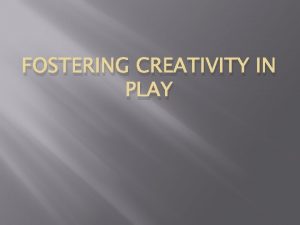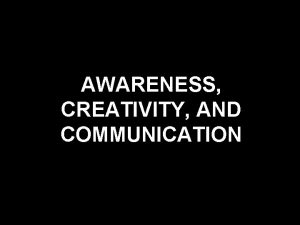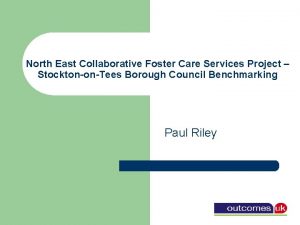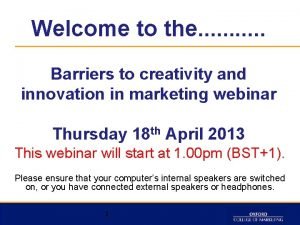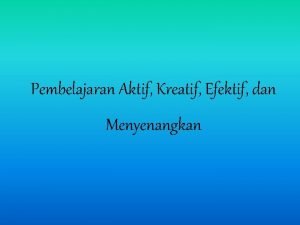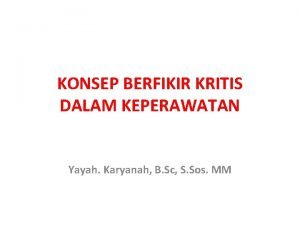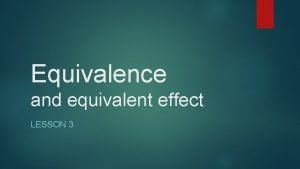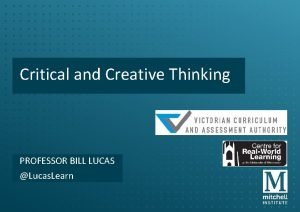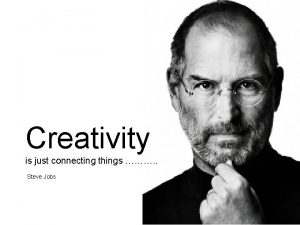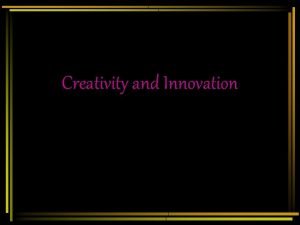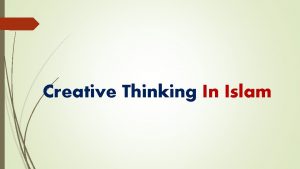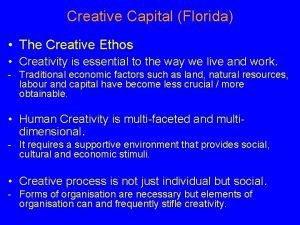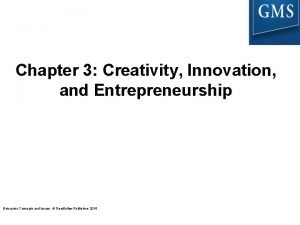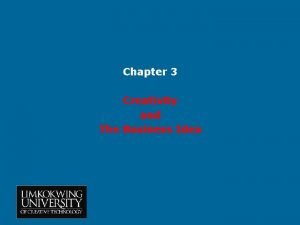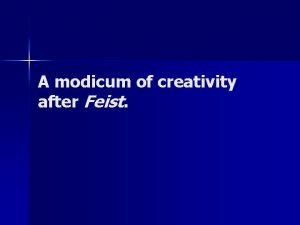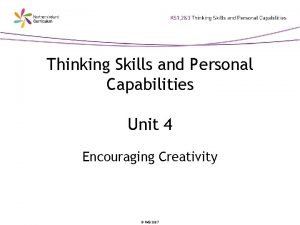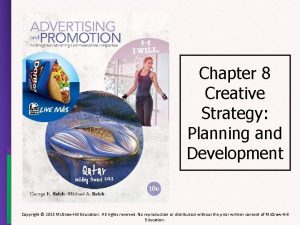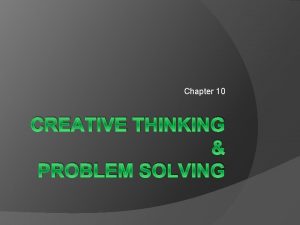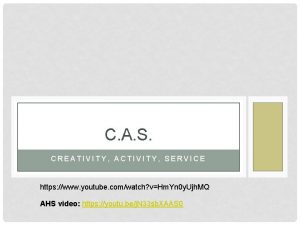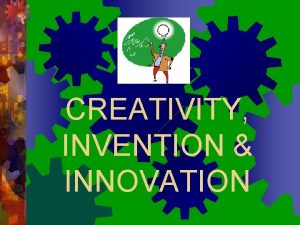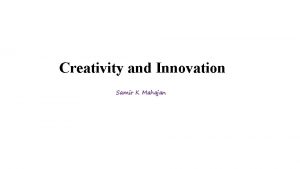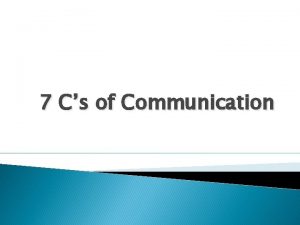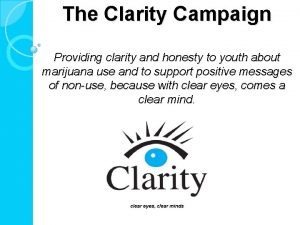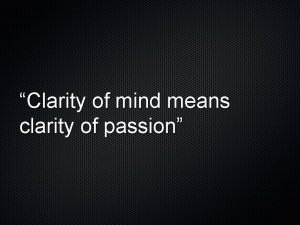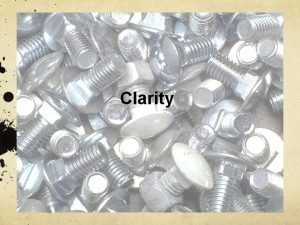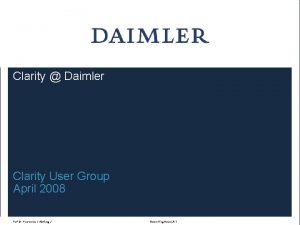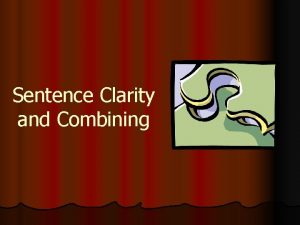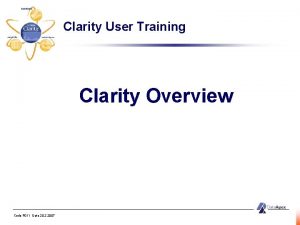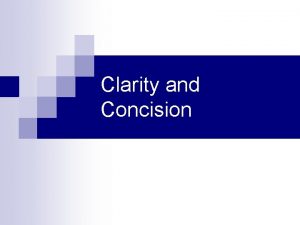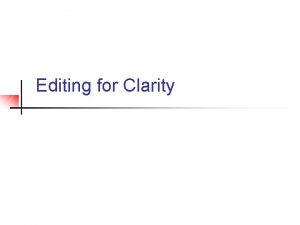EFFECTIVE COMMUNICATION The key to fostering clarity creativity









































- Slides: 41

EFFECTIVE COMMUNICATION The key to fostering clarity, creativity and cohesion.

WORKSHOP OBJECTIVES • Define communication • Identify why we communicate • Discuss the fundamental elements and concepts which support effective communication • Present the concepts of whole and partial messages • Define effective communication • Introduce the basic premise of Neuro-Linguistics • Present an overview of the four behavioral styles and the DISC System • Provide take away materials to support continued learning

WHAT IS COMMUNICATION? • Any perceived behavior - or lack of behavior in one person that causes a "significant" mental, emotional, physical, or spiritual reaction in another person is "communication. "

WHY DO WE COMMUNICATE? • We communicate with ourselves (through act of thinking) and with other people to reduce current discomforts, or needs.

CONSIDER THIS: • The more effectively we can communicate the more likely we are to get our needs met!

WHAT DRIVES US TO COMMUNICATE? There are six (6) fundamental communication needs we try to fill. To…. 1. feel respected by Self and others present (a constant human need). 2. give and/or get credible information. 3. cause or prevent action (change) - including changing or maintaining the psychological "distance" (intimacy and boundaries) between us and others. • vent - i. e. we need to (a) describe current thoughts and feelings to another person and to (b) feel deeply understood and accepted by them (vs. to get "fixed”). 1. create excitement - i. e. reduce numbness or boredom. 2. avoid something uncomfortable, like silence, a confrontation, a loss, or a conflict.

SO WHAT ARE YOU TRYING TO SAY? • To be better supervisors we have to recognize there is much more to communicating then what think…. • and there are many ways we can improve our communication style, but first we need to understand some fundamentals. →

IF YOU WANT TO BE HEARD…. FIRST YOU HAVE TO LEARN TO LISTEN 12 BLOCKS TO LISTENING • Comparing • Mind Reading • Rehearsing • Filtering • Judging • Dreaming • Identifying • Advising • Sparring • Being Right • Derailing • Placating

CAN YOU HEAR ME NOW? • Effective communicators practice active listening; seeking the signals which help them to better interpret the messages they are receiving as well as the person sending the message.

WHAT CHANNEL ARE WE ON? Increasing our channel awareness! Face to face, we communicate via three (3)"channels" at once through: • spoken words; • voice dynamics: tone + tempo + inflection + volume + accent + non-word sounds; and. . . • non-verbally (face and body) communication language.

PEOPLE ARE ACTUALLY USUALLY ON ALL 3 CHANNELS

BENEFITS OF CHANNEL AWARENESS • Being able to spot stressful signals in important communications and relationships • Being able to decode what they mean • Being able to reduce or stop such confusing messages ➝

Getting our message out there……. When we send a message we try to get two or more current needs met by exchanging up to four simultaneous messages on each of our three (3) channels: "Right now, . . . 1. I feel. . . "; 2. I need. . . "; 3. I think. . . "; 4. Relative to me, I understand your needs as. . . ” →

IT’S ALL ABOUT RESPECT Of the four (4) messages it is #4 that relates to respect which is usually sent and decoded unconsciously. 1. Remember the old saying. “It’s not what you say but how you say it!” 2. Because we all need to feel respected enough in every relationship and situation, perceived R-messages control the success of every spoken and unspoken communication exchange.

R-MESSAGES HAVE THREE BASIC INTERPRETATIONS: "Here and now, you (seem to) value your needs, worth, and dignity. . . • more than mine, so you're 1 -up (superior) and I'm 1 -down” • less than mine, so you're 1 -down (inferior) and I'm 1 -up)"; or. . . • equally with mine (we're "= / =", or "of equal respect, " here. )

EFFECTIVE COMMUNICATION REQUIRES ALL PEOPLE TO RECEIVE CREDIBLE =/= REFFECTIVE COMMUNICATION MESSAGES.

ARE WE SENDING WHOLE OR PARTIAL MESSAGES? There are four primary elements involved when we engage in whole message communications, they are: 1. Observations: what your senses tell you. 2. Opinions: conclusions you draw 3. Feelings: your emotional response 4. Needs: what you want →

TOXIC MESSAGES CONTAMINATED COMMUNICATIONS • Contaminated messages are different from partial messages in that part of the message is expressed “slyly” rather than just left out. • Contaminated messages are most destructive when they are loaded with unexpressed negative emotions and needs.

Learning to develop better messages BREAKOUT EXERCISE

EFFECTIVE COMMUNICATION HAPPENS WHEN…. each person involved meets two conditions: they. . . • Get enough of their current met (by their definition), . . . • in a way that leaves them feeling good enough about (a) themselves, (b) all others involved, and (c) the processes in and among them.

SOME TIME EFFECTIVE COMMUNICATION JUST HAPPENS…. . Effective verbal communication may happen when all people's current needs match well enough – Such as when I need to vent, and you need to maintain our relationship , and get information (about me).

MORE OFTEN THEN NOT EFFECTIVE COMMUNICATION ELUDES US… Communication Outcomes the odds of two people both achieving these two factors are 1 in 16, or about 6%! Here's why: primary needs met well enough? Feeling good enough when we're done? mine yours me you yes no no no no yes yes

IMPROVING YOUR ODDS • Requires moving to a conscious versus unconscious state when communicating • Our style of communication can be like any habit; some times it enhances our lives and some times it detracts from our lives either way the choice is ours…if we want to change our current state it takes knowledge and discipline.

TOOLS FOR BECOMING A MORE EFFECTIVE COMMUNICATOR • Neuro-Linguistics (NL) • DISC

NEURO-LINGUISTICS • Looks at the ways that humans think and experience the world effects communication. • The basic premise of NL is that… the more people are like each other, the more the like each other. • The insights provided in the practice of NL allow us to increase our sensory acuity and in turn adapt our communication styles

LEARNING TO ADJUSTING YOUR LENS • We each have a very unique“world view” • When we try understanding another person’s world view we are less likely to make judgments about people’s behavior. • We can consider the context. • The representational systems in NL relates to our senses. • The way we sense the world impacts our thoughts capabilities and beliefs.

REPRESENTATIONAL SYSTEM EXAMPLES • For example in responding to the statement: I think the Insight project is going well we might we get the following: Visual Response: “Yep, looks good to me. ” Auditory Response : “I’ve been hearing good things about it. ” Kinesthetic Response : “I feel good about the whole project. ”

SO HOW DOES THIS BENEFIT ME? • Understanding the primary mechanism through which someone best absorbs information increases your chances of sending them a message which they can receive. • It also lets you know the means of transport you must use with them to improve your odds for effectively communicating your message.

DISC An approach for achieving better communication

DISC PROFILES 1. Dominant or Directive – the Control Specialist 2. Influence or Emotive – the Communication Specialist 3. Steady or Supportive– the Harmony Specialist 4. Conscientiousness or Reflective – the Information Specialist

QUICK SELF ASSESSMENT – HANDOUT “HOW YOU BEHAVE” What’s your personality style?

VIDEOS

COMMUNICATION STRATEGIES Become FLEXABLE Develop the willingness to exercise behaviors not necessarily characteristic of your own, for the benefit of the relationship, is called behavioral flexibility or being FLEXable.

How To Identify the Four Styles Each of the four behavior styles consist of two basic elements of behavior: • More direct vs. more indirect behaviors • More supporting vs. more controlling behaviors

WHAT DRIVES THE FOUR STYLES? Relationship-oriented Results-oriented Detail-oriented Socially-oriented

BEHAVIORAL STYLES IN STRESSFUL SITUATIONS Supportives • • • Hesitant Submissive Passive Indecisive Defensive Dependent Supportives need: To know they are liked. A slow pace for comfort and security. To develop a relationship where they feel comfortable.

4 STYLES CONT. Emotives • • Manipulative Overeager Impulsive Inconsistent Time-wasting Unrealistic Superficial Emotives like: Credit for their actions. Action and interaction. A quick pace for stimulation and excitement. Prestige!

4 STYLES CONT. Reflectives • • Resist Change Slow to Act Withdrawn Resentful Doesn't Meet Deadlines Unimaginative Over-reliant on Data Reflectives need: A slow pace for the “processing of information & accuracy. ” To know they are right. This comes with understanding all principles and details.

4 STYLES CONT… Directives • • Restless Critical Blunt Intrusive Pushy Aggressive Irritable Uncooperative Directives need: To feel in control of the situation. Tangible evidence of progress towards goals. A fast pace with accomplishments.

STYLE MATRIX Support Tools Supportive • • • • Provide a secure environment Be logical and systematic Tell them about change early Let them go slow into change Show they’re important Use sincere appreciation Reflective • • • Show dependability Show loyalty Honor precedents Be tactful and reserved Value high standards Be precise and focused Emotive • • Approach them informally Provide written details Be relaxed and sociable Find times to keep the conversation light Let them tell you how they feel Use humor (Carefully) Give public recognition Directive Steer clear of gut responses Show your competence Show independence Stick to the topic Be clear about rules/expectations Respectfully explain how their behavior impacts you Communicate briefly/to the point Respect their need for autonomy Controlling

WRAP UP • No matter what our current set of communication skills we can always become more effective communicators Thank you!
 Creativity and play fostering creativity
Creativity and play fostering creativity It should convey all facts required by the audience.
It should convey all facts required by the audience. Awareness creativity and communication
Awareness creativity and communication Communication creativity critical thinking collaboration
Communication creativity critical thinking collaboration Fostering hope scholarship
Fostering hope scholarship Fostering stockton on tees
Fostering stockton on tees Fostering healthy solutions
Fostering healthy solutions Fostering teamwork
Fostering teamwork Fostering in doncaster
Fostering in doncaster Apa itu key partners
Apa itu key partners Business model canvas tripadvisor
Business model canvas tripadvisor How to overcome barriers to creativity and innovation
How to overcome barriers to creativity and innovation Usc kortschak center for learning and creativity
Usc kortschak center for learning and creativity Rule governed creativity
Rule governed creativity Lexical creativity
Lexical creativity Fungsi atau manfaat berpikir kritis dalam keperawatan
Fungsi atau manfaat berpikir kritis dalam keperawatan Thinking skills and creativity
Thinking skills and creativity Creativity innovation and invention
Creativity innovation and invention Koller 5 types of equivalence
Koller 5 types of equivalence Bill lucas creativity wheel
Bill lucas creativity wheel Steve jobs creativity is just connecting things
Steve jobs creativity is just connecting things Creativity innovation and invention
Creativity innovation and invention Creativity and innovation
Creativity and innovation Creative thinking in quran
Creative thinking in quran Creative capital definition
Creative capital definition Creativity and the business idea
Creativity and the business idea Chapter 4 creativity and the business idea
Chapter 4 creativity and the business idea Chapter 4 creativity and the business idea
Chapter 4 creativity and the business idea Creativity vs innovation examples
Creativity vs innovation examples Creativity business idea
Creativity business idea Modicum of creativity
Modicum of creativity Thinking skills and personal capabilities
Thinking skills and personal capabilities Harvard business review creativity
Harvard business review creativity Creativity support tools
Creativity support tools Creativity of linguistic knowledge
Creativity of linguistic knowledge Creativity creative acrostic poem
Creativity creative acrostic poem Planning creative strategy
Planning creative strategy Forced combination technique definition
Forced combination technique definition Cas creativity activity service
Cas creativity activity service Robert sternberg five components of creativity
Robert sternberg five components of creativity Torrance creativity test examples
Torrance creativity test examples How pixar fosters collective creativity
How pixar fosters collective creativity
